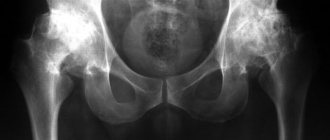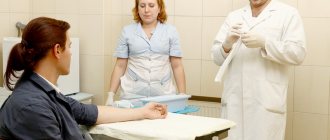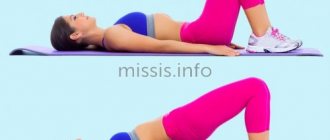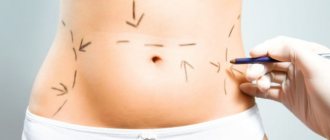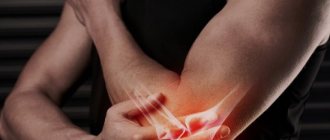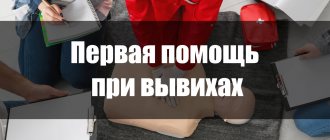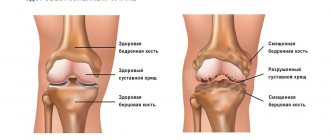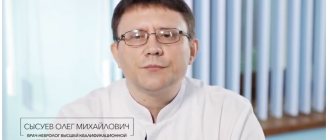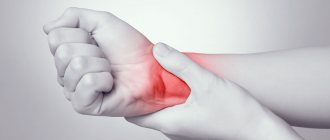Osteoarthritis (OA) of the hip joints refers to serious degenerative-dystrophic changes that occur in the cartilaginous tissues of the articular surfaces of the hip joint. Osteoarthritis with this localization is considered one of the most common joint diseases. The pathology, which mercilessly destroys the hip joint, ranks second in occurrence after gonarthrosis of the knee joints. In terms of the risk of rapid disability in the general structure of joint diseases, OA ranks first. Another specific name for the disease, which refers specifically to damage in a given area of the musculoskeletal system, is coxarthrosis.
This is what an advanced diagnosis looks like on an x-ray.
Approximately 80% of elderly people (60 years and older) have radiographic evidence of hip OA to one degree or another, and a quarter of them experience intense pain and severe motor limitations. Osteoarthritis of TB joints is diagnosed almost 2.5 times more often in women. According to statistics, a sharp increase in the incidence rate is observed in the population over 45 years of age. According to authoritative medical sources, among the established causes of the development of degenerative disease of the hip joints, congenital dysplasias lead. That is, violations of the anatomical shapes of the ends of the bones that form the joint, already present from birth.
On the left is the healthy surface of the femoral head, on the right is affected by disease.
The pathology to which the entire article will be devoted is a severe variant of a medical problem with a complex orthopedic outcome. A disproportionate number of patients with this diagnosis face permanent disability accompanied by excruciating chronic pain. People very often become dependent on outside help, lose the ability to move normally, and are unable to go to work or perform usual household chores.
The most unpleasant thing is that conservative treatment does not always bring relief; it is often necessary to take extreme measures - to relieve the patient of suffering through surgery. Fortunately, in the modern age of orthopedics, surgeons have unique innovations that provide great prospects for gaining full functionality of the problem leg, which previously could only be dreamed of. We will introduce you to all the intricacies of osteoarthritis, including treatment, in order.
Knee replacement in the Czech Republic: guarantees, prices, rehabilitation, reviews and statistics.
Find out more
Minimally invasive endoprosthetics in the Czech Republic: doctors, rehabilitation, terms and prices.
Find out more
How to stretch the joints in the pelvic area?
You can open the joints through exercises that move the pelvic bones apart. As a result, a fairly wide interarticular space is formed, where synovial fluid begins to be intensively produced. It nourishes the cartilage layer and smoothes out friction in the joint capsule.
The process of opening the joint itself is traumatic. Therefore, it is necessary to follow several rules in its implementation:
- Before performing the exercise, carefully study each step. The instructions always provide detailed information about unexpected nuances that at first glance seem unimportant for a particular exercise.
- Perform all actions gradually and slowly. This is the most important principle that will help you move forward without discomfort in your body. Rapid stretching inhibits the tissues ability to adapt naturally.
- Stop if you feel significant pain. This indicates disturbances in blood circulation.
Make pelvic opening exercises regular and systematic. At least 2-4 workouts should be done every week.
The most effective exercises for stretching the joints of the pelvic area are presented in yoga.
The need for TBS flexibility
Healthy joints must be mobile and have sufficient flexibility, since only in this state do they produce synovial fluid necessary to nourish cartilage and normal functioning of the lower extremities.
Lack of mobility of the hip joints entails:
- stagnation of blood in the pelvis, varicose veins, development of inflammatory processes in the area of the urinary organs;
- the appearance of pain in the lower back;
- sexual dysfunction;
- arthritis, arthrosis associated with the destruction of the cartilage layer;
- limitation of limb mobility.
To develop joint flexibility, it is recommended to regularly perform special physical exercises. Women who are in the later stages of pregnancy are especially advised to perform such gymnastics.
How to prepare your joints for flexibility?
Yoga for the hip joints begins with the simplest asanas. As a result of an unhealthy lifestyle, people develop stiffness in joint mobility. Therefore, you need to start studying from a preparatory position. This way the body will strengthen and stretch to the required extent. The body will tune in to perform more complex asanas. There is no need to rush and force yourself. Otherwise, a sprain or minor injury may occur. You should not count on quick results.
SYNERGEL
— the healing power of 4 natural poisons will quickly relieve joint pain!
Get Synergel at a promotion only without prepayment!
Old price: 4790₽
New price: 147₽
Contactless delivery and safe receipt of your order!
Below is a set of preparatory exercises that will make your joints more flexible.
- Sit on the surface. Straighten your back and legs. Straighten your arms in front and bend over, clasping your calves with them. Try to tilt your body as much as possible. It is important that there is no feeling of overstrain along the spinal axis. Stay in the pose for a few seconds. Each time, try to tilt your body deeper without bending your knees. Start with 2-3 inclinations and gradually increase to six.
- Get on all fours with your knees touching the floor. Gradually straighten your legs. Tension should be felt in the muscles of the thighs and calves. For more effort, place your heels on the floor.
- Lie on your back and slowly raise one leg to a right angle with the body. Direct your gaze forward. Stay in the pose for about 12 seconds. When lowering your leg, maintain a slight tension. Then raise the other leg. Repeat 2–5 times.
- Stand straight, spread your legs shoulder-width apart. Bend your left leg, lifting it off the surface, and grab it with your left hand. Pull your leg up as far as possible. Raise your right arm up, moving your head back, bend your neck. Repeat the same steps with the other leg. Do the exercise 3-5 times.
- To warm up the hip joints you need to:
- Take a sitting position.
- Bend your left leg inward, touching your heel to the middle of your pelvis.
- Right - move back so that the inner part of the thigh touches the surface. Stay in the pose for a few seconds. Feel its comfort.
- Do the same actions with the right leg.
- Repeat 3-5 times.
Doing this exercise stretches the tiny muscles of the hip joint.
Difficulties may arise when performing preparatory exercises. Don't despair. Regular exercise relieves pain.
Causes of osteoarthritis of the hip joint
The hip joint is a large, articulated synovial joint, which is called the most powerful because it bears a greater range of loads. It is formed by the spherical head of the femur and the cup-shaped cavity of the pelvic bone (acetabulum), the surfaces of which are covered with smooth hyaline cartilage. Together they represent a hinge, where their musculoskeletal contact interaction occurs.
Every day, this unique mechanism performs the most important functions, which include maintaining the weight and position of the body in an upright state (standing, sitting), ensuring motor activity during movement (walking, running, jumping, etc.), and moving parts of the body relative to each other.
The forces passing through the hip joint apparatus are quite significant. For example, in the usual position of “standing on two lower limbs” the joint experiences a load of 1/3 of a person’s weight, while standing on one limb - 2.5 times higher than the body weight, when walking and running - a load of 2-6 times exceeds the person's original weight. Experts definitely attribute the fact of significant loads to one of the explanations for the high susceptibility of the joint to destabilization and wear, and, consequently, to the development of osteoarthritis. However, to say that the cause of the disease is the natural functional physiology of the joint is fundamentally incorrect; without an aggravating factor, the pathological process is impossible.
And another important point: for the hip joint to function well, it must have a sufficient range of movements with very good stability. And this, in turn, is possible provided there are strong ligamentous muscle groups that control movement and support functions in the joint, as well as a strong articular capsule that protects and holds the bone joint. The depth of insertion of the spherical element of the femur into the acetabular bed of the pelvis also plays a huge role. Failure of the designated structures and/or incorrect anatomical parameters can clearly lead to degeneration of the articular surfaces.
This is what the joint cavity looks like through an arthroscope.
All of the above is general introductory information, it is also important to know and understand. Of course, we will not leave readers without an answer to the burning question: what specific reasons cause such a complex diagnosis? Experts name the following root causes that most often lead to osteoarthritis of the hip joints:
- genetic defects in the development of the hip joint, characterized by congenital disorders of the development and growth of bone, cartilage, ligamentous, and muscle structures of the joint (dysplasia);
- old age, since against the background of age-related changes, cartilage hydration, muscle elasticity, blood circulation in joints, etc. decrease;
- systemic pathologies, where osteoarthritis is one of the consequences (gout, rheumatism, collagenosis, diabetes, complex types of allergies, etc.);
- various chondropathy leading to modifications of bone structures related to the joint;
- chronic arthritis (long-term inflammatory phenomena in the joint due to infection, autoimmune and metabolic disorders);
- avascular osteonecrosis of the femoral head (death of bone tissue) as a consequence of local circulatory disorders of traumatic or non-traumatic origin;
- hormonal imbalance, especially in women during menopause, when the level of estrogen, which protects joints, sharply decreases;
- obesity of any stage (excess weight is the worst enemy, since it significantly increases the load on the TB department and on the limbs in general);
- previous injuries localized to the pelvis and femur (fractures, dislocations, bruises, etc.), as well as a history of surgical manipulations on the hip region;
- orthopedic disorders, in particular valgus and varus deformities of the limbs, flat feet, spinal curvatures;
- a sedentary lifestyle, which causes a deficiency of muscle mass, ligament laxity, poor blood supply and limited supply of nutrients to the hip joint, which contributes to the onset and progression of osteoarthritis;
- constant overload of the hip region and lower extremities due to intense sports training, performing work while standing with heavy lifting, long monotonous poses (especially in static positions “standing” in one place, “sitting”), long walking forced by the nature of the activity.
It is impossible not to ignore the fact that smoking and alcohol abuse also have an adverse effect on the condition of the joint. Toxic products of nicotine and alcohol lead to a critical disruption of blood circulation around the musculoskeletal organ, to depletion and irreversible death of osteochondral tissues.
Rules for performing the opening of the joints of the pelvis and hip
The joints are opened with special exercises that can move the pelvic bones apart. This creates an impressive space between them, which allows the active production of synovial fluid. Its importance for a healthy joint is enormous, since it nourishes the cartilage layer and smoothes out friction in the joint capsule.
The process of opening the bone tissue can create injury.
How to open the hip joints so that this does not happen? To do this, it is important to familiarize yourself with the following rules:
- Before you start performing stretching asana on your own, you need to carefully study the methodology for doing it. Pay attention to the nuances of the exercise.
- Do each action gradually, without haste. This method will help you improve little by little without feeling much pain, and if you do the asana quickly, the tissues will not be able to adapt naturally.
- If you feel severe pain, you should stop. This means that blood circulation is impaired.
- The main thing is the systematicity of the exercises. It is necessary to conduct from 2 to 4 workouts per week.
Yogic asanas most productively open the hip joints.
Treatment of the disease: conservative and surgical methods
Today, not a single conservative method, unfortunately, is capable of either completely stopping or reversing the pathological process of this disease. Conservatively, it is only possible to slow down the rate of progression of degenerative pathogenesis. Medication and physiotherapeutic methods, which are used in a non-invasive approach, are designed for symptomatic treatment and prevention of the accelerated rate of tissue destruction of the hip joints. In the final stages, it is useless to treat a pathologically changed joint conservatively.
The essence of physical training
The main problem that activates the process of destruction of the hip joint is a decrease in the amount of synovial fluid. The glands of the shell of the same name, lining the articulation cavity, are responsible for its production. As soon as there is less synovial fluid, the mobility of the articular surfaces is impaired and the friction between them increases. This leads to a narrowing of the joint space, which in severe situations completely immobilizes the patient. This is how arthrosis of the hip joint occurs.
This is a real image of the femoral head with stage 2-3 arthrosis. Look carefully and think, will gymnastics help in this case?
Medicines can slow down the progression of the disease, but the process cannot be stopped. At an unfavorable moment, arthrosis will lead to serious pain, which will significantly affect the quality of life. However, even at the moment when it becomes clear that endoprosthetics surgery is no longer possible, therapeutic exercises will prove extremely useful for improving the functioning of the joint, both before and after surgery.
The effect of exercises carried out at home is as follows:
- stimulation of blood flow around the damaged joint;
- restoration of muscle performance and prevention of muscle atrophy;
- stimulation of the glands of the synovial membrane due to intensive blood supply;
- reducing the progression of arthrosis;
- stretching and mobilization of the ligamentous apparatus;
- general strengthening of the body and immune system.
After any gymnastic exercises, the mood improves, which leads to an increase in a person’s ability to fight the disease.
SYNERGEL
— the healing power of 4 natural poisons will quickly relieve joint pain!
Get Synergel at a promotion only without prepayment!
Old price: 4790₽
New price: 147₽
Contactless delivery and safe receipt of your order!
A network of blood vessels that supplies tissues with useful substances that promote rapid regeneration of the cartilage surface.
However, not only the psychological factor influencing the patient plays a role in activating restoration processes in the hip joint. There are also quite tangible changes that the patient will feel after treatment through regular exercise. These include:
- increased range of motion in the joint;
- pain relief;
- increased strength in a limb;
- easier walking;
- reduction in the frequency of colds;
- improving quality of life.
Although gymnastics will not radically change the situation, the joint will still have to be replaced with prosthetics; it will help reduce rehabilitation time and speedily restore motor activity in the postoperative period. This will be possible thanks to developed muscles and well-developed tendons, as well as stable blood flow in the hip joint.
There are many options for gymnastic exercises done at home. But the effectiveness of their treatment is completely different. The most relevant training is that proposed by a professional exercise therapy instructor, as well as the classic methods of Evdokimenko and Bubnovsky. A video of classes with a physical therapy specialist clearly shows the optimal set of exercises.
Minimally invasive endoprosthetics in the Czech Republic: doctors, rehabilitation, terms and prices. Find out more
Physiotherapy therapy
Physiotherapeutic procedures are aimed at increasing blood circulation in the periarticular tissues, activating metabolism and delivery of valuable substances to joint tissues, improving lymphatic drainage, and preventing muscle atrophy. Along with the effect of physical methods, it is sometimes possible to achieve a permanent elimination of pain and inflammation, and an increase in the performance of the limb. Common physical therapy treatments with the best potential for effectiveness include:
- electromyostimulation;
- laser treatment;
- magnetic therapy;
- ultrasound treatment;
- mud and paraffin treatment;
- therapeutic mineral baths.
In advanced stages, physiotherapeutic sessions, including massage techniques, can have the opposite effect, so they should be used with caution. Orthopedic doctors emphasize that physiotherapy has the greatest benefit at stage 1, and at the beginning/middle of stage 2. If there is a final form of stage 2, any stage of 3 tbsp. physiotherapy will give productive results after surgery.
Features of the exercises
When training independently at home, it is recommended to follow the following rules:
- First study the technique of performing the asana.
- All techniques should be carried out slowly.
- If painful symptoms occur, training should be stopped.
In order for exercises aimed at opening the hip joints to be beneficial, they should be performed regularly. You need to conduct 2-3 classes per week. The first yoga sessions are best carried out under the supervision of a trainer who is thoroughly proficient in these practices.
Preparatory exercises for joint stretching
To open the hip joints, at the beginning of classes it is advised:
- sit on the ground, straighten up; stretch your arms forward, bend over and try to clasp your calf muscles as much as possible;
- standing on all fours, gradually straighten your legs;
- lie on your back, slowly raise your left leg up 90 degrees relative to your body, fix the position, slowly lower it; repeat the exercise on the right leg.
Gymnastics should begin with simple exercises for beginners, gradually moving to more complex positions.
Basic asanas
They are also performed sequentially. Only after completely mastering one asana is it possible to study another.
Warrior Pose II
Step into a lunge with your right foot in front so that your knee is at a right angle. Turn your left foot to the left, taking a stable position. Turn your body following your left leg, raise your arms and spread them to the sides. Turn your head forward so that your gaze is directed over your right hand. If in this position you see the big toe of your right foot, then the pose is performed correctly. Repeat for the other leg.
The exercise gently opens the hip joints and stretches the thigh muscles, preparing the body for the main load.
SYNERGEL
— the healing power of 4 natural poisons will quickly relieve joint pain!
Get Synergel at a promotion only without prepayment!
Old price: 4790₽
New price: 147₽
Contactless delivery and safe receipt of your order!
Plie
Place your feet as far apart as possible and point your toes out to the sides. Your thighs should be parallel to the floor. Lean forward and rest your forearms on your thighs, gently pressing on them and trying to spread them even further.
This hip stretch improves the elasticity of the inner thigh muscles, making your legs more flexible. Plie is also an excellent preparation for cross splits.
Side lunge
Step as far to the right as possible and lower into a low lunge, bending your right knee at an acute angle. The left one should be fully straightened, while you can rest on the full foot or only on its side. Try to go as low as possible to give a good stretch to the inner thigh of your right leg and open your hip joints. Repeat for the other side.
The exercise not only opens the hip joints, but also improves the flexibility of the legs, helps stretch the hips and strengthen the muscles.
Lateral traction
Get on your knees and extend your left leg to the side. Raise your right arm up and lean to the left, stretching the lateral muscles of the body. At the same time, you will notice how the back of the thigh of your left leg stretches. Hold your left hand arbitrarily. Don't forget to repeat for the other side.
An excellent hip stretch that doesn't require a high level of flexibility initially and prepares the body for more challenging poses.
Low lunge
Get into a straight-armed plank position, then step your right leg forward, planting your foot next to your right palm. Lower your left knee down to further stretch your thigh muscles. The farther you place your foot, the higher the load will be. Repeat for the left leg.
A simple yoga leg stretch will help you make your hamstrings and inner thighs more elastic and pliable.
Low lunge with a turn
Staying in a deep lunge position with your left leg in front, raise your left arm up and twist to the left. Lean on your right hand. At the same time, try to lower your pelvis as low as possible to enhance the stretch in your hips. Repeat for the other side.
In addition to the hamstrings, the exercise is a good stretch for the core muscles, increasing overall body flexibility and range of motion. The exercise is also useful for posture and opening the shoulder joints.
SYNERGEL
— the healing power of 4 natural poisons will quickly relieve joint pain!
Get Synergel at a promotion only without prepayment!
Old price: 4790₽
New price: 147₽
Contactless delivery and safe receipt of your order!
Sitting Pigeon Pose
Step into a lunge with your right foot in front and lower your knee to the floor. Release your shin and place it in front of you. The left leg lies quietly behind, resting on the arch of the foot. Lower your pelvis as low as possible, trying to touch the floor with your right buttock and thigh, and use your hands to help yourself maintain balance. Repeat for the left leg.
This hip opener stretches the gluteal muscles and hamstrings well, making them elastic and facilitating faster recovery after physical activity.
Stretching while sitting with abducted leg
Sit on the floor and spread your legs out to the sides as far apart as possible. Bend your left leg and bring your heel toward your body. The right one remains motionless. Grasp the foot and shin of your left leg, pulling it towards you. Repeat for the right leg.
The exercise stretches the quadriceps and hamstrings, opens the hip joints and improves flexibility.
Simplified butterfly sitting
Sit on the floor and spread your knees to the sides, while closing your feet together. Bend your body forward, trying to keep your back straight. Bend as low as possible to open your hip joints as much as possible and stretch your inner thighs. The closer the feet are to the body, the greater the load on the legs.
One of the best exercises for opening the hip joints, which allows you to stretch the muscles well and improve the flexibility of the hips.
Half lotus stretch
Sit on the floor and pull the foot of your right leg towards your body. Bring your left leg back so that your shin rests freely next to your body. Try to move your leg as far as possible to increase the stretch in your quadriceps. Don't forget to repeat for the other leg.
The exercise provides gentle stretching to the biceps and especially the quadriceps, and also improves the flexibility of the hip joints.
Dhanurasana (Bow pose)
You need to lie on your stomach, lift your right leg and left limbs up and clasp your ankles with your hands. Fix the resulting position.
Upavistha Konasana (Seated Angle Pose)
To do the exercise you need:
- sit on the floor, straighten up;
- stretch your legs to the sides as much as possible, without lifting your hips and knees from the ground;
- tilt your body forward, touch your forehead to your toes.
This asana should not be performed by people who have spinal diseases or suffer from chronic inflammatory processes.
Baddha Konasana (Butterfly Pose)
To take a pose you should:
- sit down, bend your legs;
- connect the feet together, pull them towards the pelvis;
- pull your knees down, fix the position;
- tilt your torso forward, keep your back straight, rest your elbows on your hips;
- stay in this position for a few seconds, then repeat the asana.
Supta Padangusthasana
The asana is performed lying on your back. One leg is extended upward, the socks are grabbed by the fingers of the same hand and brought to the head. The position is then repeated for the second limb. Beginners doing the asana for the first time are recommended to use a belt.
Podmasana (lotus pose)
Sit on the floor, spread and straighten your lower limbs. Take your foot with both hands and place it on the inner surface of the opposite thigh (the heel should approach the pelvic bones). Extend your arms and place them on your knees. Closing your eyes, you need to remain motionless for several seconds.
Gymnastics Evdokimenko
Since the early 2000s, Dr. Evdokimenko’s practice of therapeutic exercises has become widespread in medical practice. Today he is a well-known rheumatologist, a specialist in joint restoration through physical training. Has the status of academician at one of the Moscow technical universities. His medical career began in 1984, when the future specialist received a paramedic education. The further period is associated with practical work and study at the institute, which Pavel Evdokimenko graduated from in 1994. From that moment on, he chose the direction of physical therapy for various osteo-articular pathologies as his specialization.
Pavel Evdokimenko.
Further work at the arthrosis center in Moscow, and then subsequent improvements at the Research Institute of Rheumatology of the Russian Academy of Medical Sciences, prompted the doctor to develop a set of exercises that help prolong the active function of the joints. In 2003, the first book was published, telling in detail about the method of Pavel Evdokimenko. Today, exercise is recognized throughout the world and helps slow the progression of coxarthrosis. Even in the most difficult situations, when surgical intervention is already inevitable, the use of therapeutic exercises can dramatically reduce postoperative rehabilitation.
Although gymnastics can heal arthrosis, it cannot completely replace the installation of a prosthesis. However, there are significant positive qualities that are discussed below.
- Strengthening the thigh muscles. The less their atrophy, the easier it is to move the limb. A strengthened muscle frame will help reduce the load on the painful joint, thereby slowing down the progression of arthrosis.
- Activation of blood flow in the synovium. Improving the blood supply to the affected hip helps reduce the rate of reduction of the joint space. This is achieved by increasing the production of synovial fluid. As a result, friction in the joint is reduced and functionality is increased.
- Reducing osteoporosis. Achieved by increasing active movements in the joint. The processes of rarefaction of bone tissue are reduced, as the work of osteoblasts is activated.
- Strengthening the back frame. Since physical training stimulates muscle activity not only in the thigh, but also in the buttock and lumbar region, the load on the affected joint and spine is further reduced. This makes movement easier and also relieves pain.
- Increasing joint resistance to physical stress. This is achieved through long training.
- Easy adaptation in the postoperative period during joint replacement. Since the muscles, as well as the ligamentous apparatus, are in an optimally developed state, even the first steps after surgery are easier to bear, and rehabilitation will be short and painless.
Gymnastics video:
All exercises according to Evdokimenko’s method are performed many times. No major changes in the joint will occur within a month of training, so you need at least six months. But the systematic use of gymnastics promotes significant clinical improvement. The patient will feel a significant improvement in walking, as well as a decrease in pain.
Coxarthrosis grade 3
Joint pain becomes constant. They appear both during the day and at night. The gait changes - lameness appears when walking. Joint mobility decreases, bones become deformed, and muscles adjacent to the damaged area atrophy. The affected leg becomes shorter. Tilt towards the shortened limb leads to deformation of posture and curvature of the spine (scoliosis). An X-ray image shows the virtual absence of a gap between the surfaces of the joint rubbing against each other or their complete fusion, confirming the deformation of the joint and significant growth of osteophytes. At this stage, the patient may lose the ability to move independently. For grade 3 coxarthrosis, joint replacement surgery is often prescribed.
Gymnastics according to Bubnovsky
One of the famous specialists in kinesitherapy - movement treatment, is Professor Sergei Bubnovsky. His entire career, starting from his student days, was devoted to joint diseases. The purpose of the developed set of exercises is to increase the motor activity of the hip joint, thereby preventing the development of ankylosis. The essence of the technique is simple - the more the patient makes active movements in the joint, the longer the synovial fluid will remain in it. This slows down the progression of coxarthrosis, and patients are given the opportunity to postpone surgery. There are only two main conditions for performing training - movements must be smooth, and classes must be conducted daily.
Doctor Bubnovsky.
Below are the most famous exercises of Professor Bubnovsky.
- Knee bending. A simple exercise that is accessible even to people with little training. It is necessary to lie on your back, bend your legs at the knee joints with maximum effort, and then immediately straighten them. Holding in a bent position is not required, as frequency of movement is important. Repeat 15 times.
- Pulling the knee towards the stomach. It is important to perform the exercise with maximum dedication, even through slight pain. Its essence is simple - lying on your back, raise your knee, clasp it with your hands and try to reach it to your stomach. Multiplicity of execution: 15 times with each leg.
- Lifting the buttocks. Lying on your back, bend your legs at the knee joints without lifting your heels from the floor. Then, using tension in the muscles of the limbs, raise the buttocks as high as possible. You can't help with your hands. Repetition frequency – up to 15 times.
- Leg raises. Starting position: lying on your stomach. The legs are extended as much as possible and are on a hard surface. It is necessary to alternately raise the straightened leg and immediately lower it. Repeat up to 20 times.
- Spreading the feet. Starting position – sitting on a chair. The legs are pressed tightly against each other. It is necessary to spread your feet, trying to move them to the sides as much as possible. There will be some pain in the hip joint, but this is not an obstacle to continuing exercise. The repetition rate is 10 times.
Despite the numerous differences, there are many similarities in the exercises of Bubnovsky and Evdokimenko. The main thing is that in both cases it is possible to stabilize the functioning of the hip joint, which has a positive effect not only on maintaining its mobility, but also on accelerating rehabilitation in the postoperative period. Professor Sergei Mikhailovich Bubnovsky proposed a set of exercises designed specifically for early recovery after endoprosthetics. Their essence lies in slowly spreading and bending the legs at the knee joints, starting with the simplest movements. Similar developments were proposed by Dr. Sergei Makeev, but his exercises are complemented by breathing exercises and self-massage of the hip joint. This helps to enrich the body with oxygen, which increases the metabolic rate in the affected joint, thereby preventing the progression of arthrosis. You can learn more about Sergei Makeev’s exercises by watching the video.
Drug treatment of arthrosis of the hip joint
Treatment of osteoarthritis of the hip joint with drugs is carried out strictly as prescribed by the doctor. In case of exacerbation and severe pain, it is allowed to take conventional analgesics or gentle anti-inflammatory drugs (ibuprofen), but no more than 10 days before contacting a specialist. Otherwise, the picture of the disease will be blurred and it will be difficult for the doctor to select adequate treatment for arthrosis of the hip joint.
There are several medicinal groups of drugs for the treatment of arthrosis of the hip joint. In the complex treatment of arthrosis of the hip joint with drugs, 5 main pharmaceutical groups are used.
Anti-inflammatory drugs in the treatment of osteoarthritis of the hip joint
Swelling, stagnation of blood and other fluids, local fever and pain - these common symptoms of inflammation in arthrosis not only poison the patient’s life, but also aggravate the course of the disease. Over time, they lead to tissue starvation, depletion of synovial fluid, which “feeds” the cartilage and disruption of its viscosity (due to which friction destroys the surface of the articular membrane!), muscular dystrophy and persistent deterioration in mobility.
But the main danger of inflammation is the death of cartilage cells - chondrocytes. When they break down in large quantities, they create an accumulation of enzymes that “eat away” the surface of the articular cartilage.
Therefore, to relieve inflammatory symptoms and restore tissue metabolism, 2 groups of anti-inflammatory drugs are used: non-steroidal (NSAIDs, NSAIDs) and glucocorticosteroids.
NSAIDs are considered gentler, although they can also affect the digestive system. That's why they are appointed first. In the treatment of grade 2 arthrosis of the hip joint - in courses or as needed.
These include: Artradol, Nimesulide, Ibuprofen, Meloxicam, Ketoprofen, Xefocam, Indomethacin, Diclofenac.
If NSAIDs fail, rheumatologists prescribe the “heavy artillery” - corticosteroid drugs. They immediately relieve even severe pain and inflammation, but they cannot be taken for a long time and in large dosages. Like any hormonal drugs, they can affect the weight and condition of internal organs, and if the therapeutic dose is exceeded, they can aggravate the course of arthrosis.
The drugs of choice for the treatment of grade 3 arthrosis of the hip joint are: Hydrocortisone, Diprospan, Prednisolone, Methylprednisolone.
Chondroprotectors for osteoarthritis of the hip joint
Although anti-inflammatory drugs relieve symptoms, they do not solve the problem - they do not restore the destroyed surface of the cartilage and do not enrich the synovial fluid with glycosaminoglycans. Therefore, effective treatment of arthrosis of the hip joint is unthinkable without the drugs chondroitin and glucosamine sulfate, which supply the body with building material for the formation of new cartilage cells.
Since the metabolism in cartilage tissue is very slow, chondroprotectors need to be taken for a long time - 3-6 months annually. But, with lifelong preventive use, they help achieve drug-free remission.
Chondroprotectors include: Artracam, Elbona, Teraflex, Movex, Protekon, Dona, Chondroitin Complex, Alflutop.
Angioprotectors and microcirculation correctors
Inflammation and microtraumas that accompany arthrosis disrupt the blood supply around the affected joint. But it is the capillaries that bring nutrients to the boundaries of the joint capsule.
The following help relieve swelling and improve tissue trophism: Troxevasin, Troxerutin, horse chestnut extract, Detralex, Actovegin, Pentoxifylline.
Muscle relaxants
When the supporting function of a joint is impaired, the body tries to compensate for it using muscles and ligaments that are not designed for such almost continuous load. Due to chronic overstrain, pain and spasms appear in the muscles. These cramps may interfere with sleep or walking.
To eliminate them, in the treatment of osteoarthritis of the hip joint, the following are prescribed: Mydocalm, Baclofen, Sirdalud, Tolperisone.
External and warming agents
Drugs in this group have a vasodilating effect. They help relieve swelling, reduce pain and psychologically distract from joint discomfort.
Usually, for the treatment of arthrosis of the hip joint, products based on animal poisons or burning plant extracts are used: Viprosal, Apizartron, Cobratoxin, Larkspur, Espol, Capsaicin ointment.
Gymnastics for arthrosis
Lesions in the hip joint occur with a frequency of up to 10% among all population groups. If we take only the age over 50 years, then the prevalence of pathology is significantly higher. Up to 70% of people suffer from coxarthrosis, and another third of this figure suffers from tendon damage. This disease is called trochanteritis. It occurs due to overload in the work of the limb. The tendons stretch, microcracks appear, and then aseptic inflammation develops. Untreated trochanteritis leads to limited movement in the hip joint, which contributes to the progression of arthrosis.
X-rays can distinguish arthrosis from trochanteritis. In the second case, the joint space does not change.
Whatever the symptoms, exercise will help alleviate them, which will affect the patient’s activity in a positive way. However, exercise alone is often not enough. Doctors of various specialties use different treatment regimens for the disease. The most relevant ones are discussed below.
- Plasmapheresis. The essence of the procedure is to cleanse the blood of immune complexes that damage bone tissue. The method is not bad in preventing the progression of the disease, but it is not able to restore already impaired joint functions. It is necessary to repeat the procedure many times, since immune complexes will again accumulate in the plasma.
- Taking NSAIDs. Drug therapy is aimed only at relieving acute inflammation and pain. Does not reduce the progression of joint space narrowing. Negatively affects the gastrointestinal tract, causing erosions and ulcers in the upper sections.
- Swimming. Exercising in the pool helps improve range of motion in the joints. These workouts can perfectly complement gymnastics done at home.
- Introduction of stem cells. The advertising of the method is excellent - aging slows down, which means destructive processes in the joint are reduced. In practice, the technique does not work, as has been proven by numerous controlled studies, so it is no longer used at present.
- Unique healing gymnastics. This is the main method that has truly positive results on the functioning of the joint. Neurologist professor Irina Bubnova considers this method of treatment mandatory for all categories of patients.
However, no method can compare in effectiveness with endoprosthetics. Only surgery can radically change the quality of life of a patient suffering from deforming arthrosis of the hip joint. But as an additional aid to patients to facilitate postoperative rehabilitation or slow the progression of coxarthrosis, physical exercise helps better than other treatment methods.
Diagnosis of coxarthrosis
Timely diagnosis and proper therapy will help stop the progression of the disease, relieve pain, and normalize motor activity. Treatment of coxarthrosis of the hip joint is carried out by orthopedic doctors: orthopedists, traumatologists and rheumatologists.
For correct diagnosis, the following types of examinations are prescribed:
- visual inspection, tactile examination, specification of complaints;
- laboratory tests of blood and urine;
- X-ray;
- CT scan;
- ultrasonography;
- Magnetic resonance imaging.
Video
1Did you like the article? Share with friends:You may also be interested in Treatment 0
Treatment of hip diseases at home Hello, dear visitors! From our review you will find out which hip joint treatment is used and Treatment 0
X-ray of the hip joint in a child and an adult Hello, dear visitors! In today's review we will find out what a hip x-ray is. Treatment 0
Restoration of hip joint cartilage Hello, dear guests of the site! Problems with the musculoskeletal system can occur not only in the elderly, Treatment 0
Displacement of the hip joint: symptoms and treatment in adults Good day, dear site visitors! In this review we will find out what Treatment 0 is
Causes, symptoms and treatment of hip cysts Good day! Joint problems are quite common and cause a lot of inconvenience. Attraction 0
Pinched nerve in the hip joint: symptoms and treatment Good day, dear visitors! Shooting pain in the thigh area is a negative sign that
Comments: 1
- Vladimir 01/14/2021 at 13:10
Thank you for the good yoga lesson, I’m 64, my joints hurt, my mobility is limited, and at times I have acute pain in my left hip. I will practice your exercises.Answer
Add a comment Cancel reply
Name *
Email *
Comment Search: Site headings
- Diseases
- Treatment
- Rehabilitation
- Endoprosthetics
- About the site
- All articles
- Feedback
- Privacy Policy
- Terms of use
textarea>header>header>header>header>header>header>
Release form of drugs for the treatment of arthrosis of the hip joint
Depending on the clinical manifestations of arthrosis and the patient’s lifestyle, the rheumatologist prescribes drugs for the treatment of osteoarthritis of the hip joint in various forms.
Tablets, capsules, powders
These products for the treatment of hip arthrosis are easy to dose and take with you. All you need to take is a glass of water. Also, the blister or packaging allows you to track how many days the course has already lasted. Such drugs have good bioavailability (90% for tablets and 95% for sachets, such as Artracam). But anti-inflammatory tablets can have a negative effect on the mucous membranes of the stomach and intestines - for gastritis, ulcers, colitis, it is better to prefer injections for the treatment of osteoarthritis of the hip joint.
Injections for intramuscular and intraarticular administration
Anti-inflammatory drugs, muscle relaxants and chondroprotectors are usually administered by injection. This guarantees maximum bioavailability and is gentle on the gastric mucosa, but usually requires the presence of a medical professional. Making intra-articular injections without special qualifications is strictly prohibited!
